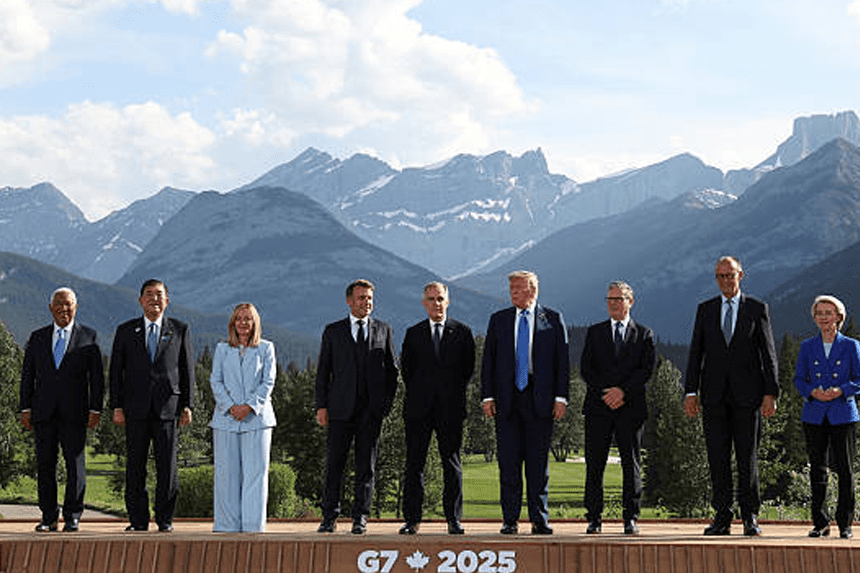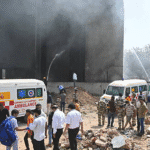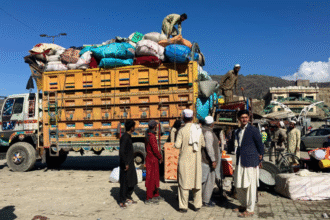World leaders issued a united statement calling for a Middle East truce at the most recent G7 conference in Canada, stressing especially the stoppage of the carnage in Gaza. The exhortation for de-escalation highlighted their dedication to long-term peace and regional security. Leaders underlined Israel’s right to defend itself, but also stressed that a truce and diplomacy were necessary to prevent a more general war.
- Why Early Trump Left the G7 Summit?
- Is military involvement by the US planned in the conflict?
- What has the reaction been to the Conflict?
- On Iran, what stance has Trump adopted?
- Regarding the escalation, what part did Israel play?
- How did the G7 decide on their statement on the conflict?
- Was there any development on other fronts during the Summit?
- In what ways does this summit stand out from past G7 conferences?
- How Is Washington Balancing Support and Diplomacy in Mideast?
- Conclusion: Can diplomacy rule among growing tensions?
As the Israel-Iran confrontation turned into a fifth day of direct strikes, tensions were running high. Against this background, the G7 asked for moderation and communication in order to stop more human losses and regional anarchy.
Why Early Trump Left the G7 Summit?
Citing pressing Middle Eastern events, US President Donald Trump shortened his summit visit. The White House claims that the growing confrontation between Israel and Iran drove the choice. According to sources, Trump intended to call an emergency session with the National Security Council upon his arrival back in Washington.
Trump underlined the seriousness of the situation developing in the Middle East, even while he said his summit attendance was successful and highlighted a new trade agreement with the UK. Emphasizing the importance of quick response, he referred to the problem as “big stuff”.
Is military involvement by the US planned in the conflict?
Trump’s quick comeback and improved military posture notwithstanding, all the US authorities denied that America was getting ready to support Israeli actions against Iran. Pete Hegseth, the defense secretary, said extra resources would be sent to the area to support defense initiatives rather than offensive action.
Still, after Trump advised Iranians on social media to flee Tehran, implying knowledge of upcoming assaults, rumors developed following his sudden departure. Soon later, reports of explosions throughout Tehran confirmed worries of escalation.
What has the reaction been to the Conflict?
Observing the gravity of the matter, G7 international leaders supported Trump’s early departure. If the US could guarantee a Middle East truce, French President Emmanuel Macron declared, it would be a major diplomatic triumph.
Although Australian Prime Minister Anthony Albanese missed a planned bilateral meeting with Trump, he described the action as “understandable”. Arguments over Russia-Ukraine tensions and different opinions on the Israel-Iran conflict tested the G7’s unity. Still, leaders came to a consensus on a last word that strengthened their dedication to Israeli security.
On Iran, what stance has Trump adopted?
Trump underlined on social media and during the meeting his resistance to Iran’s nuclear aspirations. Claiming he had made a fair offer, Tehran turned down, he cautioned Iran, You cannot have a nuclear weapon”.
His message was clear: either follow denuclearizing guidelines or pay fines. By endorsing Israeli operations, the US president also indicated a more general strategy, hinting that Iran was the main cause of regional unrest.
Regarding the escalation, what part did Israel play?
Last week, Israel stepped up its military operations with a surprise airstrike aimed at Iran’s elite military and nuclear professionals. Since then, Israeli air strikes have allegedly claimed over 220 Iranian lives. Iran started several missile strikes in response, resulting in damage and injuries in Tel Aviv among other cities.
Notwithstanding these initiatives, experts claim Israel has not yet destroyed Iran’s nuclear infrastructure. Some analysts feel that only the United States has the means—such as bunker-busting bombs—to destroy firmly buried Iranian installations like those at Fordow.
How did the G7 decide on their statement on the conflict?
While Trump was allegedly rejecting a joint statement on the crisis, late Monday, the G7 produced a consensus agreement. The statement supported Israel and denounced Iran as the main cause of regional unrest.
Emphasizing “Iran can never have a nuclear weapon,” they underlined the importance of rapid worldwide cooperation to stop further degradation and reflected Trump’s view. Leaders have as their common objective a sustainable Middle East truce that reduces the bloodshed and creates diplomatic opportunities. Here is the link to our article on Israel Ceasefire Stalls
Was there any development on other fronts during the Summit?
Notwithstanding geopolitical concerns, Trump reached a deal with UK Prime Minister Sir Keir Starmer to lower tariffs and increase bilateral trade. Trump joked that this was because of his affection for the UK, therefore reassuring reporters that the nation was free from upcoming import duties.
He also met with Mark Carney, the prime minister of Canada, to discuss a possible trade agreement between the US and Canada. Aiming to settle reciprocal tariffs impacting numerous sectors, Carney proposed that an agreement might be completed in thirty days.
In what ways does this summit stand out from past G7 conferences?
This was the second early Trump departure from a G7 summit. He left the conference in Quebec in 2018 to make a historic visit to North Korean leader Kim Jong UN. As such, fast-growing international tensions shaped early departure this year.
The urgency and possible scope of conflict, nevertheless, define the difference. Analysts say that should a Middle East truce fail quickly, the whole area may enter more general conflict, attracting several world powers.
How Is Washington Balancing Support and Diplomacy in Mideast?
Washington seems to be using a two-track approach: discouraging more violence while supporting friends with military reinforcements sent and diplomatic initiatives in progress. Both public and private messages from Trump keep advocating denuclearization of Iran.
Still, uncertainty lingers. Any error might start a bigger regional conflict. Thus, the G7 and the international community’s emphasis will probably remain on reaching a permanent Middle East truce, a target now considered essential for world stability.
Conclusion: Can diplomacy rule among growing tensions?
Originally scheduled as a forum for political and economic cooperation, the G7 conference became the platform for emergency diplomacy. Leaders from all throughout the world today recognize the Middle Eastern delicate balance. The simultaneous demand for a Middle East ceasefire and de-escalation highlights the indispensable need for diplomacy above violence. Leaders now share a common sense of urgency since they agree that unbridled fighting might turn into a more general war. Nowadays, diplomatic involvement is not only a choice but also a worldwide need.








